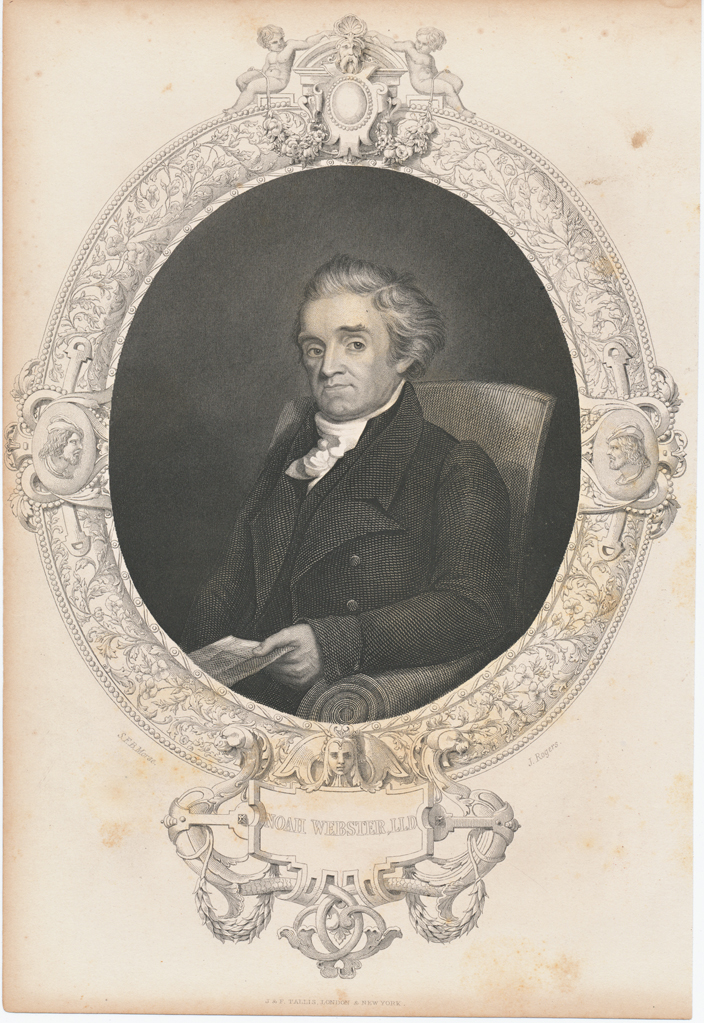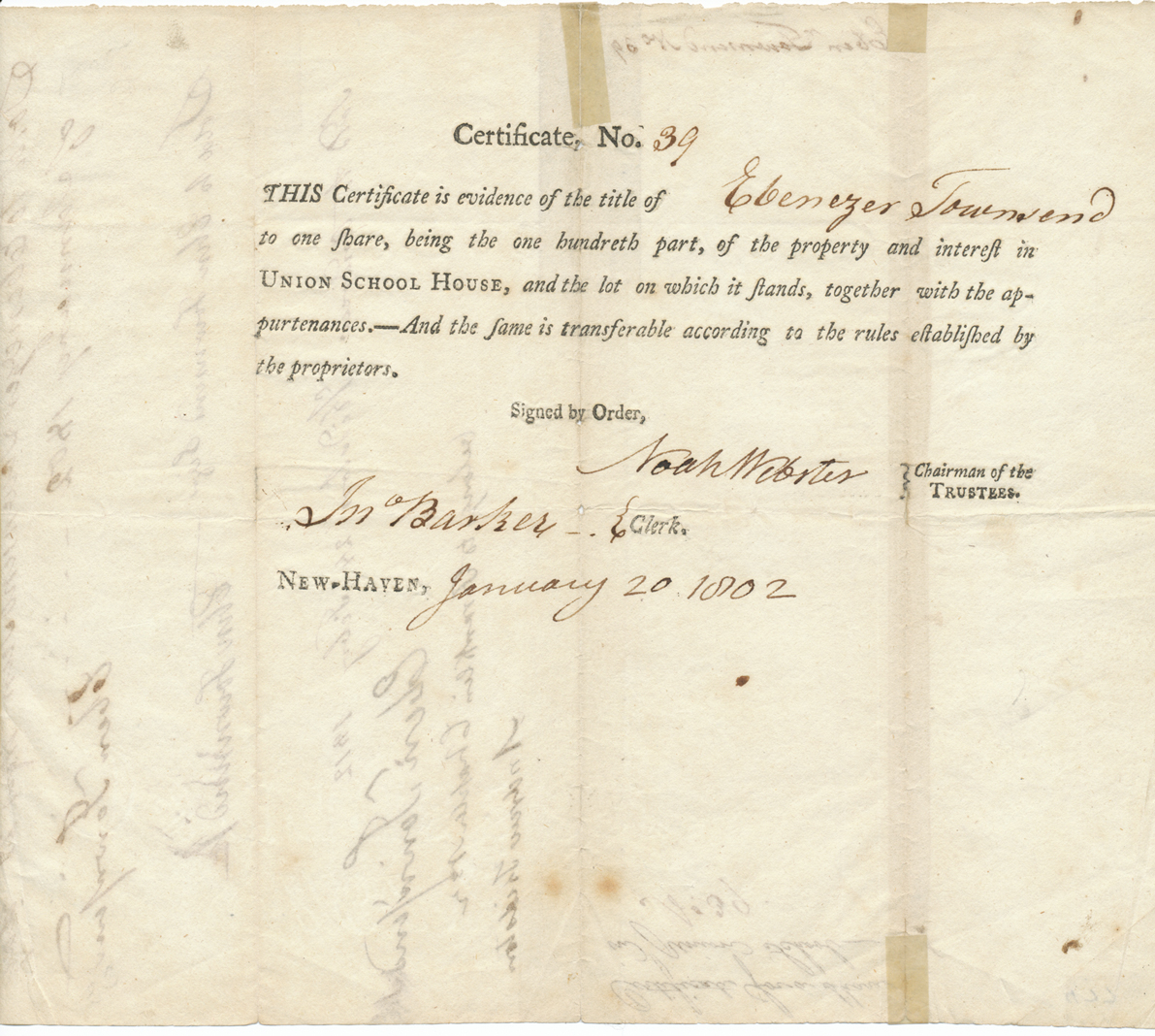Noah Webster
Noah Webster
Rare Typeset Stock Certificate Signed - 1802
Uncommon typeset Stock Certificate Signed “Noah Webster” as Chairman of the Trustees of the Union School House, 1/2 page, oblong 4to, New Haven, CT, January 20, 1802.
He signs certificate #39, “evidence of the title of Ebenezer Townsend to one share, being the one hundredth part, of the property and interest in Union School House, and the lot on which it stands…” Also signed by clerk “Jn. Barker.” Transferred twice on verso. Two clean fold separations repaired on verso, one with scotch tape and one with Japanese paper; also with strips of Japanese paper at left edge and at fold edges on recto, otherwise in very good condition. Accompanied by a beautiful 4to engraving of Webster.
The Union School House was erected in the year this certificate was issued. Webster was not only a teacher, but also a pedagogical theorist; he designed a program for children’s study that took into account their stages of development, making him one of the first to do so.
NOAH
WEBSTER (1758-1843). American author, essayist, educator, and lexicographer; his groundbreaking dictionary was largely responsible for standardizing American English and distinguishing it from British English.
In 1782-83 Noah Webster taught in a classical school at Goshen, New York, and became convinced of the need of better textbooks of English. As a teacher, he had come to dislike American elementary schools. They could be overcrowded, with up to seventy children of all ages crammed into one-room schoolhouses, poorly staffed with untrained teachers, and poorly equipped with no desks and unsatisfactory textbooks that came from England. Webster thought that Americans should learn from American books, so he began writing a three volume compendium, A Grammatical Institute of the English Language. The work consisted of a speller (published in 1783), a grammar (published in 1784), and a reader (published in 1785). His goal was to provide a uniquely American approach to training children. His most important improvement, he claimed, was to rescue “our native tongue” from “the clamor of pedantry” that surrounded English grammar and pronunciation. He complained that the English language had been corrupted by the British aristocracy, which set its own standard for proper spelling and pronunciation. Webster rejected the notion that the study of Greek and Latin must precede the study of English grammar. The appropriate standard for the American language, argued Webster, was, “the same republican principles as American civil and ecclesiastical constitutions”, which meant that the people-at-large must control the language; popular sovereignty in government must be accompanied by popular usage in language. “The truth is general custom is the rule of speaking-and every deviation from this must be wrong.”
The Speller was arranged so that it could be easily taught to students, and it progressed by age. From his own experiences as a teacher, Webster thought the Speller should be simple and gave an orderly presentation of words and the rules of spelling and pronunciation. He believed students learned most readily when he broke a complex problem into its component parts and had each pupil master one part before moving to the next. Ellis argues that Webster anticipated some of the insights currently associated with Jean Piaget’s theory of cognitive development. Webster said that children pass through distinctive learning phases in which they master increasingly complex or abstract tasks. Therefore, teachers must not try to teach a three-year-old how to read; they could not do it until age five. He organized his speller accordingly, beginning with the alphabet and moving systematically through the different sounds of vowels and consonants, then syllables, then simple words, then more complex words, then sentences.
The speller was originally entitled The First Part of the Grammatical Institute of the English Language. Over the course of 385 editions in his lifetime, the title was changed in 1786 to The American Spelling Book, and again in 1829 to The Elementary Spelling Book. Most people called it the “Blue-Backed Speller” because of its blue cover, and for the next one hundred years, Webster’s book taught children how to read, spell, and pronounce words. It was the most popular American book of its time; by 1861, it was selling a million copies per year, and its royalty of less than one cent per copy was enough to sustain Webster in his other endeavors. Some consider it to be the first dictionary created in the United States, and it helped create the popular contests known as spelling bees.
Slowly, he changed the spelling of words, such that they became ‘Americanized’. He chose s over c in words like defense; he changed the re to er in words like center; he dropped one of the Ls in traveller; at first, he kept the u in words like colour or favour, but he dropped it in later editions.
Unauthorized printing of his books, and disparate copyright laws that varied among the thirteen states, led Webster to champion the federal copyright law that was successfully passed in 1790.
In 1806, Webster published his first dictionary, A Compendious Dictionary of the English Language. The following year, at the age of 43, Webster began writing an expanded and comprehensive dictionary, An American Dictionary of the English Language, which would take twenty-seven years to complete. To supplement the documentation of the etymology of the words, Webster learned twenty-six languages, including Anglo-Saxon and Sanskrit. Webster hoped to standardize American speech, since Americans in different parts of the country spelled, pronounced, and used words differently.



